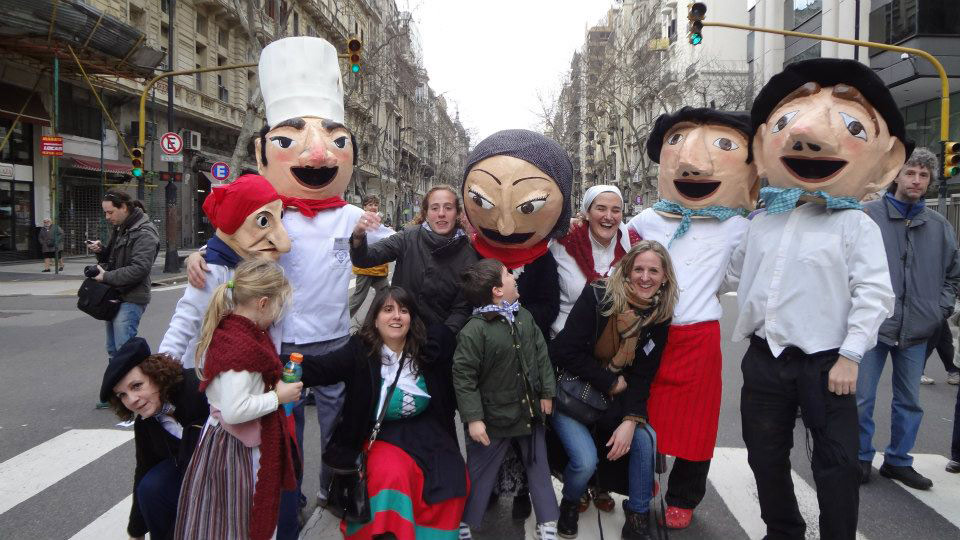basque heritage worldwide

05/15/2014

ADVERTISING
Joseba Etxarri/EuskalKultura.com. Downtown Buenos Aires was dressed in Ikurriñas on Sunday. Sponsored by the city of Buenos Aires and under the organization of the Laurak Bat Basque club, thousands of people were on the Avenida de Mayo, with the Casa Rosada just a few meters away at another edition of “Buenos Aires Celebrates,” this time dedicated to the Basque Country. A world of Basque-Argentineans and people interested in Basque music, dance, culture, and vital Basque joy permeated the heart of the capital.
-Satisfied? Buenos Aires Celebrates the Basque Country was very successful despite the bad weather.
-The weather didn’t help, but despite it was very exciting and gratifying to see the public’s response and that of our people, to see the young, and not so young with such a great attitude, so much good will and joy, dancing and singing in Basque, even in the rain. It was a success.
-What does the Buenos Aires Celebrates (BAC) consist of?
-It is a festival sponsored by the Directorate of Collectivities of the City of Buenos Aires that began in 2009 so that local communities could show, and share their cultures, history, and their identity with their neighbors and tourists. It takes place on the Avenida de Mayo, backbone of the historic and civic center of Buenos Aires. Other communities that have been featured are the Italian, Greek, Irish, Brazilian, Russian, Ukrainian, Mexican...
-How is it that the Basque Country was featured?
-The City Government contacted Laurak Bat and after various meetings they understood our reality and the necessity to be recognized as a differential collective. They took into account the strong history of Laurak Bat, with 137 years of uninterrupted institutional life in Buenos Aires. We celebrated the first edition in August 2011, and we invited all the Buenos Aires Basque institutions to the city with a magnificent reception. Even the Euskal Echea School (founded in 1904, with thousands of students) was invited and participated with its student body. The second edition took place in August of 2012 and nearly 20,000 people attended, various TV networks were there and there was impressive media coverage. In 2013, we were preoccupied with other activities and decided to postpone until 2014, with new success, “despite the rain” (smile).
-What is the festival like?
-It is similar to town festivals in the Basque Country. The street becomes a boardwalk with booths where cooking is done in front of you, with booths that present culture, publications, music, instruments, photos, pamphlets, models of Basque farmhouses…You can research the origin of your last name, and place them on a map of the Basque Country, there is a children’s corner where they can color, sing, and listen to stories…Many Basque clubs provide food…Two stages are build where groups and dancers perform simultaneously, cooking classes are taught by renowned chefs. This year we added Herri Kirolak, thanks to the General Las Heras Basque club and the Basque Government had a stand where writer Toti Martinez de Lezea and the La Oreja de Van Gogh group raffled concert tickets for their Argentinean tour. In the afternoon there was a Donostia Tamborrada.
-How did the public react?
-There was a very emotional moment when we formed a human chain for the Gure Esku Dago initiative. It started from the stage and stretched for two blocks. It was something that is hard to forget, the emotion in the faces of hundreds of thousands of Basques, Argentines, who joined hands to show their support. There were also other moments, like the student parade from the Euskal Echea School, the Tamborrada, the presence of La Oreja de Van Gogh, cooking classes with Chefs Itziar Aguirre and Takehiro Ohno…There was a funny story about Chef Ohno, who is Japanese and lived for several years in Donostia, when he asked us to participate in the Tamborrada. He told us that he had always wanted to but while in Donostia he was always working and so never could. So we gave him a barrel and an apron and so he marched smiling ear to ear.

[The human chain joining the Gure Esku Dago initiative last Sunday in Buenos Aires, where Arantxa Anitua is seen in the middle of the picture joining hands with many other Basques and Argentineans at Buenos Aires Celebrates (photoEE)]
-Is it really possible to feel and celebrate Euskadi thousands of kilometers away?
-I am the granddaughter of Basques from Hernani (Gipuzkoa) and Arteaga (Bizkaia). My grandparents knew each other at Laurak Bat and so did my parents: we were trained and grew up steeped in this culture, with Laurak Bat as our second home, we live as proud Basques. I think that there are many Basques there who cannot even imagine how deep our Basque feelings go. The Diaspora in Argentina has sustained the Basque sentiment for years 14,000 kilometers away with culture, tradition, and commitment, while attentive to what is happening in our beloved Euskal Herria.
ADVERTISING
ADVERTISING
ADVERTISING
ADVERTISING
ADVERTISING
© 2014 - 2019 Basque Heritage Elkartea
Bera Bera 73
20009 Donostia / San Sebastián
Tel: (+34) 943 316170
Email: info@euskalkultura.eus